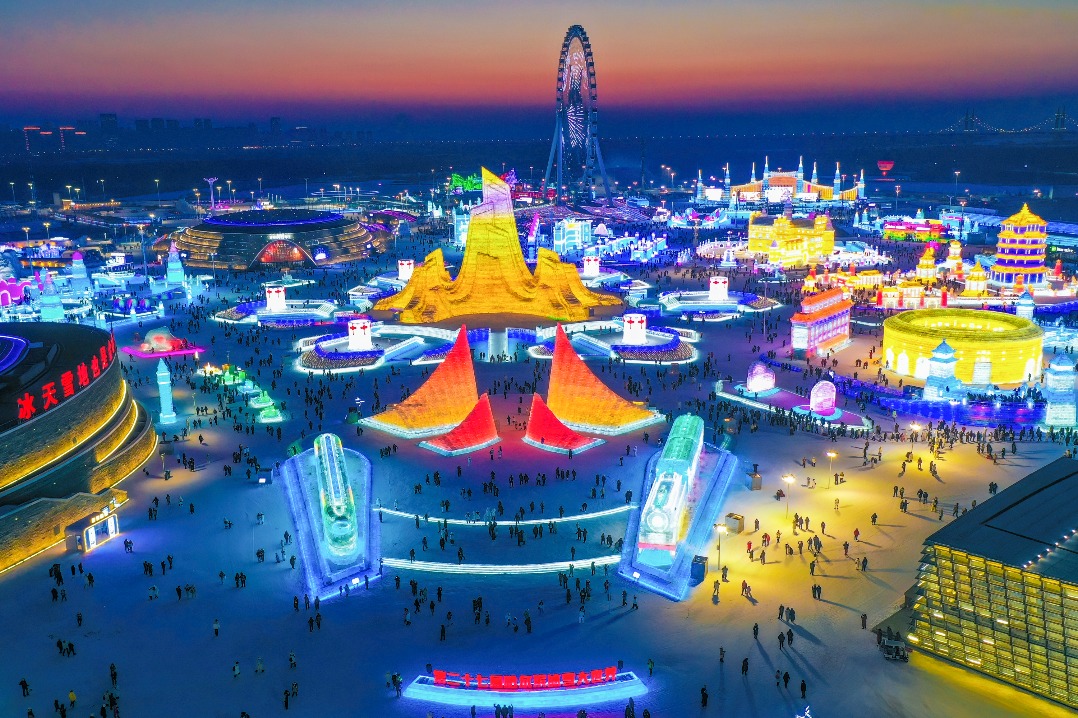Legendary duo charms new age
Homegrown superheroes Wukong and Nezha steal the spotlight at animation festival, Xu Fan reports.

Clad in an exquisite suit of armor and carrying a long staff over his shoulder, the "Destined One" — the protagonist warrior tasked to revive Monkey King in the blockbuster game Black Myth: Wukong — strides into a crowd.
Alongside nine fellow "warriors "and "villains" from the game, one of China's most popular action role-play games in the global market, this special team quickly caused a sensation, drawing screams from fans and surrounded by smartphones and cameras at the 21st China International Cartoon and Animation Festival.
As one of the country's largest and most popular animation events, the five-day festival concluded earlier this month in Hangzhou, East China's Zhejiang province, drawing over 3,000 industry insiders from 2,573 companies and organizations across 42 countries and regions.
Wang Hanyi, a 28-year-old former restaurant owner from Northeast China's Liaoning province, cosplays the Destined One — a character resembling the Monkey King. Now living with his wife in Ningbo, Zhejiang province, Wang began portraying the character last September, drawn in by the game's stunning visual effects and its intriguing, thought-provoking storyline.
"In the past, most domestic fans dressed up as characters from popular American or Japanese shows at anime conventions. But now, more and more people are wearing the costumes and makeup of Chinese characters — like Wukong, a superhero unique to our culture. I feel so proud of that," says Wang.
As a devoted fan, Wang once traveled to several cities in search of the perfect costume maker, eventually spending nearly 50,000 yuan ($6,956) on a custom suit of armor and 1,800 yuan on the jin gu bang, the magical staff wielded by Wukong.
With growing recognition for his vivid portrayal of the Destined One, Wang, along with his fellow cosplayers — all skilled in bringing characters from Black Myth: Wukong to life — was invited to perform at the festival.
Hosting a wide range of activities, from master classes to a voice-acting contest, the festival received more than 1.46 million visitors and generated a total transaction and consumption value worth around 1.48 billion yuan ($205.5 million), according to the organizers.
The Monkey King and Nezha — two iconic mythological figures made famous by the 16th-century classic Journey to the West, which has inspired many movies, TV shows, and cartoon works — were among the festival's biggest attractions.
Ne Zha 2, China's biggest box-office hit and the world's fifth highest-grossing film of all time, won the Golden Monkey King Awards' top honor: the General Award for Animated Feature Film.
"The success of Black Myth: Wukong and Ne Zha 2 reflects the strong appeal of traditional Chinese culture and the growing popularity of domestic productions among audiences," says Xu Jiang, vice-chairman of the China Federation of Literary and Art Circles.
Josh Selig, a veteran American television producer who delivered a master class speech during the festival, describes Ne Zha 2 as a "funny, thrilling, and completely original film".
"It clearly demonstrates China's great creative and technical prowess. Most of China's leading animation studios contributed to this film, so it's truly the product of the entire Chinese animation industry. I believe we are entering a renaissance of Chinese animation, and Ne Zha 2 is the first of many triumphs," he adds.
Selig also suggests that a successful Chinese film could benefit from greater cooperation with international filmmakers to expand its global audience. "It's worth noting that the success of Ne Zha 2 has been largely confined to the domestic Chinese market," he says, attributing this to its storytelling structure, which differs from that of Western feature films.
Xuan Xuejun, deputy dean of the School of Animation and Games at the China Academy of Art, reveals that the Black Myth: Wukong Art Exhibition — a popular destination for many fans traveling to Hangzhou for the festival — has attracted over 160,000 visitors since its launch in early April.
As the curator of the exhibition, Xuan recalls, "There have been queues almost every day." He still clearly remembers seeing a young fan who brought a folding bed and started lining up outside the ticket booth — which opens at 9 am — as early as midnight.
"The exhibition reflects the charm of various aspects of traditional Chinese culture, such as architecture and sculptures," comments Xuan.
For instance, one major scene features a temple adorned with many colorful clay sculptures of Buddhist figures, inspired by the Shuilu Temple, located 60 kilometers southeast of Xi'an in Shaanxi province. With over 3,700 painted clay sculptures spanning from the walls to the dome, this temple — built around 1,400 years ago — had endured through six dynasties, standing as a treasure trove of ancient and exquisite sculptures with rare colors. The scene was partly re-created during the exhibition.
According to Xuan, some foreign visitors have also developed an interest in visiting the exhibition. He personally guided groups from multiple countries including Bulgaria, Poland, France, Germany, Singapore and Thailand.
With the rapid advancement of artificial intelligence, AI-powered animation production has become a major topic of discussion at the festival.
Selig, also founder and president of China Bridge Content — a company specializing in international cooperation — says that AI is transforming every stage of animation production, from story development to final output, and its impact continues to evolve daily.
However, he adds a note of caution, saying that while AI is reducing costs, it remains uncertain whether it can truly enhance the quality of animation. "Many believe AI will harm the deep human connection that we all seek when enjoying a film or any other work of art," he adds.
Wang Yueping, a veteran industry insider from Suzhou in Jiangsu province, says that even in today's information-saturated world, the ability to craft a compelling story — a distinctly human creative skill — remains beyond the reach of AI.


Today's Top News
- Experts: Lai not freedom fighter, but a pawn of the West
- Hainan evolves as gateway to global markets
- Opening up a new bridge between China and world
- Tour gives China-Arab strategic trust a boost
- China accelerates push for autonomous driving
- Opening of new gateway can help foster global economic and trade cooperation






























